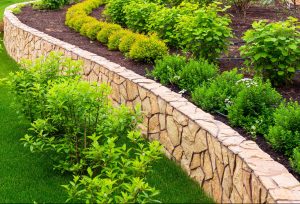The following is geared toward shrub beds. Before you set a budget, draw up plans or buy materials, here are some things that may help, or muddy up the decision-making waters. The 20-year plan for a shrub bed is trimming for shape and adding mulch every year or two. Basic rules include picking the correct plants for the sun exposure of a given area and our current or potential water situation. Space the plants at their mature size, even if you think it looks weird. You can use annual plants to fill in the gaps for a year or so. Leave enough room behind the plants for maintenance of the bed, the house, shed, or whatever.
The following is how I work shrub beds. I do not amend the entire bed with compost, expanded shale, volcanic sands, the eye of newt, or whatever. There are 2 reasons for this: 1) Spend the money and effort around the plant and not on bare dirt that will be covered with mulch. 2) The plants will have to live in the native soil so lightly amending the soil you put back in the hole will give them a good start. Installing landscape or weed barrier fabric will help keep most of the unwanted growth from coming up through the bed for years. Once the fabric is in place and the plants are staged in the bed, the shovel work starts. Dig the hole about two to three times as wide as the pot and not too deep. It is better to be on the shallow side than the deep side. The sides of the holes should be rough, not smooth. A third of the backfill should be compost and expanded shale. I also use Wells Brothers “Jump Start” in the hole. In the past, I have also used lava and green sand, cornmeal, dried molasses, peat moss, and Eye Of Newt.
Adding 3” to 5” of mulching is the last step but one that cannot be skipped. Mulch aids in weed suppression and most important, moisture retention. You can do everything right but if the plants dry out they are goners. The two most popular types of mulch are hardwood and cedar. Hardwood comes out of the bag black but will fade in relatively short order, especially in full sun. Cedar comes out of the bag faded but smells better. I give the edge to cedar mulch due to its insect-repellent properties. You can also find cypress, pine bark, rubber, and dyed mulches. Nothing wrong with cypress but if you must use pine I would rethink your plant selection. Dyed mulches are used when a particular appearance is wanted. For me, the rubber mulch is what they do with old tires and serves no use in a landscape unless you have plastic or metal plants.
And here comes the shameless plugs. We sell lava and green sand, cornmeal, dried molasses, 4 types of compost, expanded shale, Jump Starter, hardwood and cedar mulch plus shovels, rakes, and other types of garden hardware. We do not carry cypress mulch, pine bark mulch, rubber mulch, or eye of newt!






